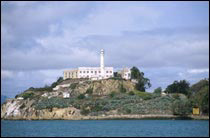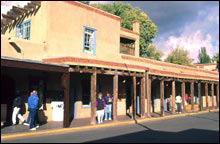Spanish Place Names

 Alcatraz Island, now part of the Golden Gate National Recreation Area, draws over a million visitors each year |
The Spanish were among the first Europeans to explore what is now the United States, and the first to found a permanent settlement here (St. Augustine, Florida, in 1565). From Alaska's Madre de Dios Island to Mexico, Maine, the United States is dotted with Spanish place names. Here are a few.
Alamo: meaning "cottonwood." This tall softwood tree gave its name to a number of U.S. places, including the memorable chapel-fort in Texas and the town of Los Alamos in New Mexico, where atomic bombs were produced.
Alcatraz Island (California): from "álcatraces," pelican. A sizable pelican population once lived on this rocky island in the San Francisco Bay.
Boca Raton (Florida): from "boca de ratónes," a Spanish term applied to nearby inlets. It translates as "mouth of the mouse" (not "rat," which is "rata") and may refer to the jagged rocks at these inlets. It has also been suggested that "ratónes" was a term used for the pirates who might hide in such a place.
California: The state was named for a mythical land described in a popular Spanish novel from around 1500, Las sergas de Esplandián (The exploits of Esplandián) by Garcia Ordóñez de Montalvo.
Cape Canaveral (Florida): from "cañaveral," canebrake. The promontory NASA made famous takes its name from the thickets of cane that grow in sandy areas.
Colorado: "reddish." The state is named for the reddish color of mud found in the Colorado River.
In 1846, during the Mexican War, Commodore John Sloat captured the Mexican village of Yerba Buena and renamed it San Francisco. |
El Paso (Texas): "passage." The border city of El Paso lies at a small gap between the Rockies and the Juarez Mountains of Mexico. This narrow passage has made the city a hub for both north-south and east-west travel.
Florida: "Flowery." Some say that Spanish explorer Ponce de Leon named the land for the Spanish term for Easter, Pascua de Florida (Flowery Feast), because he first saw the land during the Easter season. Others believe he named it for the area's lush flowers.
Fresno (California): "ash tree." The central Californian city and county are named for their abundant ash trees.
La Brea (California): "tar." The tar pits in this famous part of Los Angeles have yielded amazing fossils for more than 100 years.
Las Cruces (New Mexico): "crosses." The city is named for the burial ground of some 40 travelers who were killed by Apaches in 1830.
|
Las Vegas (Nevada): "meadows." Before casinos and neon lights defined Las Vegas, the area was noteworthy as a desert oasis with artesian springs.
Los Angeles (California): "angels." In 1781 Spanish settlers founded El Pueblo de Nuestra Señora la Reina de Los Angeles de Porciúncula (The Town of Our Lady the Queen of the Angels of Porciúncula). It became known as La Ciudad de los Angeles (City of Angels), and then just as Los Angeles.
Los Gatos (California): "cats." At the time this western California city was founded, many wildcats roamed the area.
Montana: from "montaña," mountain. Representative James M. Ashley of Ohio suggested using the Spanish word in honor of the territory's mountainous western part.
Nevada: "snow-covered." The mountains in this western state are often capped with snow.
San Antonio (Texas): "Saint Anthony" (of Padua). On the feast day of St. Anthony in 1691, Spanish explorers found and named the eponymous river. Later the name was given to the city, which was founded in 1718.
 Adobe buildings in Santa Fe, New Mexico |
San Francisco (California): "Saint Francis" (of Assisi). The city by the bay was once a Mexican village named Yerba Buena (Good Grass). In 1846, during the Mexican War, Commodore John Sloat captured and renamed the settlement for its San Francisco de Asís mission (better known as Mission Dolores), which was founded in 1776.
Sangre de Cristo Mountains (Colorado and New Mexico): "blood of Christ." This mountain range was named for the red glow cast on it by the setting sun.
Santa Fe (New Mexico): "holy faith." Spanish settlers founded this oldest U.S. capital nearly 400 years ago, as La Villa Real de la Santa Fe de San Francisco de Asís (The Royal City of the Holy Faith of Saint Francis).
| More Hispanic Heritage Month features! |
